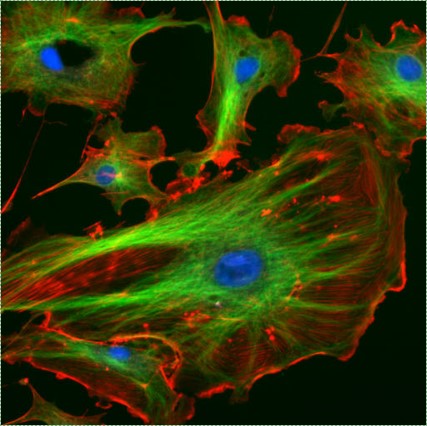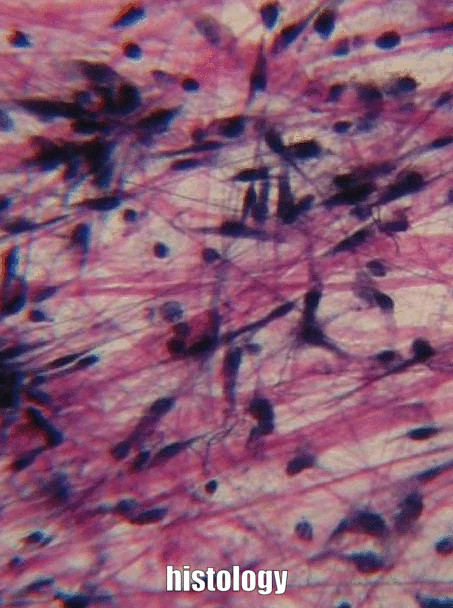Chapter outline
- Overview of cell biology
- Inside the cell:
- Cell membrane, cytoplasm
- Organelles
- Outside the cell:
- Extra-Cellular Matrix (ECM)
- Extra-Cellular Fluid (ECF)
- Neither in nor out:
- Cell division
- Cell death
- Cell junctions

The cell is the basic unit of life. It is the smallest thing that we call living (without arguing about viruses), and the human body is made of 10 trillion of them. We started off as a single cell, and its the purpose of this class to learn a little bit about how that one cell developed into the trillion-celled organism you are today. Nearly all of the instructions for making trillions of cells-- how to make them, when to make them, where to make them-- are found within that single cell.

Every human cell is surrounded by the plasma membrane. The plasma membrane separates the cell from its environment, and allows certain materials to enter and leave the cell. Phospholipids and cholesterol form a barrier that separates the cell from the external environment, and allows us to point at that cell and call it a thing. Trans-membrane proteins span the plasma membrane, and decide what goes in or out. These proteins can also receive signals from other cells and relay that information to the inside of the cell, perhaps even to the nucleus.

The nucleus contains a cell's DNA. This DNA is the instructions for making all of the proteins inside of and outside of a cell. It is also the instructions for when and where to make these proteins. For instance, epithelial cells of the oral mucosa will not make collagen or enzymes that secrete calcium and phosphate into the ECM. On the other hand, epithelial cells that differentiate into ameloblasts will make these proteins, by expressing their genes, after being told to do so by other cells called neural crest cells.


Visible throughout the cytoplasm are small specks made of protein and RNA called ribosomes. These structures translate mRNA instructions that came from the nucleus into protein. Groups of three mRNA nucleotides, called codons, instruct the ribosome which amino acid to add to a protein. Like the regulatory regions of DNA, the RNA found in the ribosome itself-- not the mRNA instructions but ribosomal rRNA, is a type of RNA that folds up into specific shapes that, along with the ribosomal proteins, perform the enzymatic reaction of translation. Free-floating ribosomes in the cytoplasm synthesize proteins that remain in the cytoplasm, such as keratin or enzymes that mediate apoptosis.

The mitochondria are where the majority of Adenosine Tri-Phosphate (ATP) is produced. ATP is made of Adenosine, plus three phosphate (PO43-) groups-- pay attention to the phosphate part, it is also a major component of bone, enamel, dentin and cementum. ATP powers almost all cellular processes, including the transcription and translation of mucous proteins within a salivary gland, the electrical signals sent by neurons in the tongue when food enters the oral cavity, and the contraction of myo-epithelial cells to cause salivation. Mitochondria burn glucose, using oxygen, and harness some of the energy released in the form of ATP.

The lysosomes are small compartments surrounded by the same phospholipids as in the plasma membrane. Inside the lysosomes are acids and digestive enzymes that can be used to destroy stuff inside the cell when it wears out, or materials that the cell has gobbled up from outside (e.g. debris, bacteria).

The ER is a series of interconnected tubes surrounded by a phospholipid bilayer-- similar to lysosomes, only bigger, more tubular, and not full of acid. The smooth Endoplasmic Reticulum (sER) is where cells produce lipids and store excess calcium. The rough Endoplasmic Reticulum (rER) is covered in ribosomes. Proteins made by these ribosomes wind up inside the rER, then travel to the golgi apparatus, and either wind up being secreted (such as mucous proteins) or stay within the plasma membrane (such as cell-junction proteins, or receptors for morphogen molecules).

The Golgi apparatus is another set of tubes, similar to the rER. Vesicles shuttle proteins made in the rER to the Golgi apparatus, where the proteins are modified. Often, these proteins will have sugars attached to them, making them glycoproteins. New vesicles take these proteins to the plasma membrane, where they are either secreted or become a part of the plasma membrane. I will cover the role the secreted protein collagen plays in enamel and the periodontal ligament. I will also cover the shared role of the secreted glycoprotein fibronectin and the membrane-bound protein integrin have in healing damaged gingival tissue.

The cytoskeleton is a nextwork of long proteins within the cytoplasm. This network gives the cell its shape, the ability to change its shape, or to move. Shown here, these cells have their microtubules and actin filaments stained red and green. These proteins are not generally visible on more old-fashioned histology images.
| Ground Substance |
| Fibers |

Another important molecule found in ground substance is a large polysaccharide called Hyaluronic Acid (HA). Like fibronectin, cells can bind to and travel over HA (using a different type of plasma membrane protein), which has applications in dentistry, such as helping cell of the gingiva stick to a dental implant and form a bacteria-resistant seal. We can't see fibronectin or HA without using some modern imaging tricks, which is why they are listed in as ground substance, and not in the next section, fibers.
In addition to their structural role as a scaffold, guiding cells to new locations, ground substance molecules can also provide cells with information. This information tells cells where they are located, and what they should be doing. For instance, when a stem cell binds to fibronectin, fibronectin can instruct the stem cell to express different genes and differentiate into a new type of cell, such as an odontoblast, and begin secreting dentin. Getting cells to the correct location is nice, but they need to know what to do when they get there. This happens during tooth formation, but also in reponse to tooth injury. As we learn more about how ground substance instructs stem cells, we get better at helping teeth repair themselves. I find it unfortunate that many textbooks gloss over ground substance as just the gelatinous material outside of a cell, which is why I have gone into it in more detail, and glossed over mitochondria.
Three extracellular proteins were visible under a light microscope a century ago, so they were grouped together as fibers of the extra-cellular matrix. Like fibronectin an other ground-substance proteins, fibers are secreted by cells called fibroblasts.


Cell division, or mitosis, the the process by which one cell makes a copy of itself, producing two identical daughter cells. Early in development, as we are growing from a single cell to a trillion cells, lots of mitosis occurs.
When a cell is not undergoing mitosis, it is said to be in interphase. This is the time where a cell might be doing its job, such as producing fibers for new ECM, or a cell might be preparing for mitosis. Before cell division can occur, a cell must have roughly double of everything. During mitosis, everything is divided in half between two new daughter cells. Not all cells are capable of mitosis-- in fact, most cells in an adult have differentiated and are performing tasks, they are too busy to reproduce. We say they have exited the cell cycle. To repair damage, tissues have stem cells which are capable of dividing. Cell division will produce two daughter cells, one daughter remains a stem cell, and the other differentiates into whatever cell is needed. A tissue will have a constant supply of stem cells, as long as the stem cells don't die before they can undergo mitosis. As we get older, our tissues don't heal as well because we have fewer stem cells.
Stem cells are named based on how many different types of cells they can potentially become. The uni-potent stem cells of the oral epithelium become keratinocytes, and only keratinocytes. The multi-potent Ecto-Mesenchymal Stem Cells turn into dentin, pulp, cementum and periodontal ligament. The omni-potent fertilized egg becomes every cell in a human, plus more.

To go through interphase and prepare for another round of mitosis, cells go through a series of cell cycle checkpoints. This helps to regulate the timing of cell division, which in turn ensures that the correct amount of tissue growth occurs. The passage through cell cycle checkpoints is timed internally, by the cell itself. This involves slow, but regular phophosrylation of proteins called cyclins. Cyclins are transcription factors that can activate genes that allow progression through to a checkpoint. The speed of this process can be sped up or slowed down by external signals, such as growth factors. Growth factors are hormones that are secreted into the ground substance of a tissue. The density and stickiness of the ground substance influences how far the growth factor diffuses. If diffusion is limited, the growth factor only speeds up growth in a localized area. This is important in the formation of new organs, such as teeth. Other growth factors might spead over a wide area. This allows different organs to grow at roughly the same speed. Ensuring all the teeth are roughly the same size requires this pattern of growth factor release.

All cells contain a group of cell-surface receptor proteins and intra-cellular enzymes that allow them to undergo programmed cell death, or apoptosis, when instructed. Programmed cell death is absolutely critical to multi-cellular life, which is an odd thing to say. Without it, as cells reached the end of their lifespan-- which for epithelial and blood cells is really short-- they would release the contents of their lysosomes and mitochondria. As you may recall, the contents of these organelles are highly acidic, which could damage or kill neighboring cells. If those neighboring cells died as a result, they too would release their lysosomal and mitochonrial contents, causing even more damage. When this happens in the human body it is called tissue necrosis. That's not all, a dead cell spews out DNA, and DNA is really long and stringy and tends to be very sticky. This can trap other cells and prevent them from migrating properly, which is great if you are trying to trap and kill bacteria, but otherwise not something you want to do to your neighboring cells.
| Cell-to-cell junctions |
| Cell-to-ECM junctions |

A single twig breaks, but the bundle of twigs is strong--Tecumseh.

